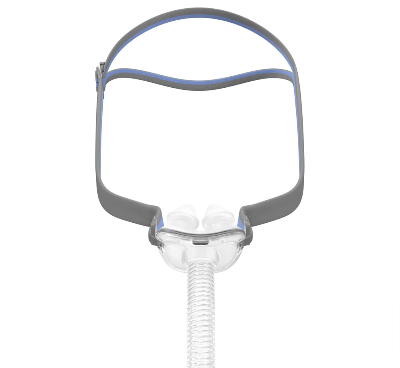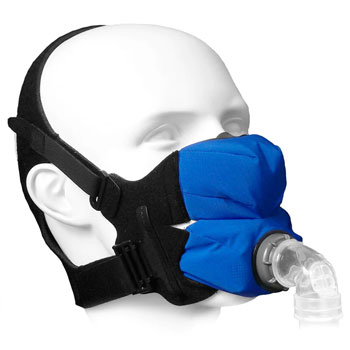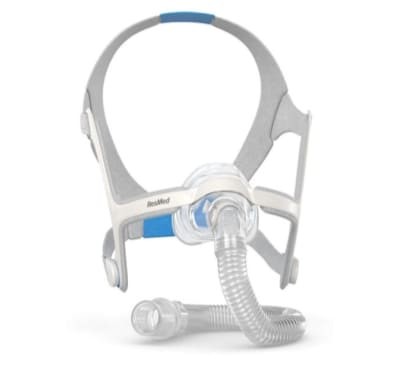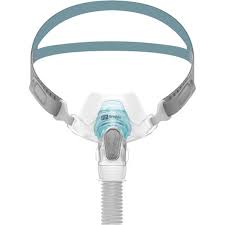Editor’s note: The FDA has issued a recall alert for the ResMed AirFit N20. The reason for the recall is that ResMed is updating the labeling and warnings on this product, as it contains magnets that could interfere with the functioning of certain medical implants or devices, which the FDA warns could cause “serious harm or death.” For more on the recall, you can visit the full statement from the FDA.
Nasal CPAP masks cover just the nose and deliver a steady stream of air pressure to keep the airways open during sleep for those with sleep apnea. These are one of the most popular mask types for a variety of reasons; they tend to be more comfortable for some, work well with a high or low-pressure setting, and are secure.
If your healthcare provider has recommended a CPAP nasal mask for you, we’ve got you covered. In this guide, we’ll go over the four best CPAP nasal masks for 2024, including the pros and cons of each one. We’ll also discuss nasal CPAP masks in general — what to look for when buying one, how to wear and clean one, and more.
Best CPAP Nasal Masks
- ResMed AirFit P10 Nasal Pillow CPAP Mask – Editor’s Pick
- SleepWeaver Elan CPAP Mask – Best Budget CPAP Nasal Mask
- ResMed AirFit N20 Nasal CPAP Mask – Most Comfortable CPAP Nasal Mask
- Fisher & Paykel Brevida™ Nasal Pillows Mask Fit Pack – Best CPAP Nasal Mask for Side Sleepers
ResMed AirFit P10 Nasal Pillow CPAP Mask – Editor’s Pick
ResMed AirFit P10 Nasal Pillow CPAP Mask
The ResMed AirFit P10 is a quiet nasal mask with a unique split-strap headgear design that’s easy to adjust and allows full visibility.
Lofta Score
4.50 / 5
Why the ResMed AirFit P10 Earned Editor’s Pick
Wearing the ResMed AirFit P10 Nasal Pillow Mask should feel the closest to wearing no mask at all, which we think is the mark of a great CPAP mask. This mask is a pillow mask, meaning it covers only the nostril area, delivering air pressure into the nose. The Airfit P10 has a unique split-strap headgear design, which allows for minimal contact on the face.
The mask itself is designed to be light and comfortable while remaining securely attached to the face, and the CPAP machine accompanying it makes less noise than its predecessor.
This mask is so comfortable and effective that it won a Red Dot Award for its product design.
Our Take: This mask is ideal for those who wear glasses, have facial hair, or just don’t like the feeling of something touching their face during the night. It’s also reasonably priced and simple to put together.
What We Liked
- It’s quiet – According to ResMed, this mask reduces sound to just 21 decibels– quieter than a soft whisper.
- Lightweight and comfortable – The ResMed AirFit P10 Nasal Pillow Mask makes minimal contact with your face, covering only the nostrils and including a strap that only touches along the cheeks.
- Allows for full visibility – If you get a little claustrophobic with a large mask that impedes your vision or doesn’t allow you to wear glasses at night, this smaller mask might be a good fit for you.
- Easy to adjust headgear – The new QuickFit headgear clip makes the straps easier to adjust as needed.
Potential Drawbacks
- Might irritate the nostrils at first – Nasal pillow masks like this one have two shallow prongs that insert slightly into the nose. If you’re not used to this, these can be somewhat irritating at first.
- Not as stable as a full nasal mask – For those who move around a lot during the night, a nasal pillow mask may not stay on as well as a full nasal mask that covers the nose.
- May not work as well for high-pressure needs – For those who have severe sleep apnea and need more air pressure from their mask, a nasal pillow mask may not work as well1 as a nasal or full-face mask.
SleepWeaver Elan CPAP Mask – Best Budget CPAP Nasal Mask
SleepWeaver Elan CPAP Mask
The SleepWeaver Elan is an affordable but quality-made CPAP mask, available in three different sizes. It’s made from hypoallergenic materials that make it comfortable and easy to use.
SleepWeaver Score
4.50 / 5
Why the SleepWeaver Elan Earned Best Budget CPAP Nasal Mask
The SleepWeaver Elan CPAP mask is a standard nasal mask, which means it will cover the entire nose rather than just the nostrils. While it is a slightly bulkier mask, it is also less expensive, making it an ideal choice for shoppers on a tighter budget or who may not have insurance fully covering their CPAP device.
Luckily, less expensive does not mean cheaply made in this case. The SleepWeaver Elan is still made from high-quality hypoallergenic materials and should fit comfortably, coming in three different sizes.
Adding to this mask’s value is that it comes with free shipping, as well as a FeatherWeight connector tube with purchase.
Our Take: For those who prefer a full nasal mask and are looking to spend less money, the SleepWeaver Elan is a good mask choice. Despite its lower price tag, it seems to still be well made and for most sleepers, should fit comfortably.
What We Liked
- Hypoallergenic materials – This mask is made without latex or silicone, making it a good buy for anyone with an allergy to either of these materials.
- No rigid plastic frame – Rather than using a rigid, plastic frame, which can press into the skin, this mask is made with a flexible and comfortable cloth.
- Minimal to no contact at the nasal bridge – The cushion on this mask is smaller than other masks, so there should be minimal contact along the bridge of the nose, which should be helpful for overall comfort
- Budget-friendly – This mask costs around 90 dollars, whereas many other masks retail well over 150 dollars.
Potential Drawbacks
- Potential air leaks – Some sleepers report air leaks and a poor seal with this mask, particularly when changing positions throughout the night.
- Difficult to clean – The FeatherWeight tube included with this mask can be difficult to remove, making it more of a hassle to clean.
- May be hard to adjust – With the velcro straps, this mask may be more difficult to adjust, as well as put on and take off, than other masks.
ResMed AirFit N20 Nasal CPAP Mask – Most Comfortable CPAP Nasal Mask
ResMed AirFit N20 Nasal CPAP Mask
This full nasal mask provides a secure seal to ensure no leaks happen during the night. The design uses InfinitySeal silicone cushions for maximum comfort while allowing full visibility.
ResMed Score
4.40 / 5
Why the ResMed AirFit N20 Earned Most Comfortable CPAP Nasal Mask
Unlike the first ResMed mask we mentioned, this one is a full nasal mask, which means it is a bit more secure — a good thing for those who toss and turn at night. However, it still allows for good visibility.
Both the headgear and the frame itself feel soft against the face, which is great news for those who want something that won’t be distracting and bothersome when they try to fall asleep. The comfort and fit of this mask are the product of years of innovation by ResMed, and as such, it is their most popular mask.
Our Take: We think this mask is a really good combination of a snug, solid-feeling fit, along long-lasting comfort. As such, it’s slightly more expensive, but the upside is that it comes with free shipping and a 30-day money-back guarantee.
What We Liked
- InfinitySeal Silicone Cushions – These cushions are flexible and should create a solid seal, so you won’t have to worry about your mask leaking as you change positions through the night.
- Quick elbow release – A common complaint for CPAP users is difficulty getting in and out of bed during the night. This mask’s quick-release elbow should allow you to easily get up in the night without having to remove the mask.
- Low profile design – This mask’s low profile allows for clear vision and should be comfortable for those who wear glasses.
- The headgear is padded – Even the headgear on this mask is cushioned, making for a more comfortable night’s sleep.
Potential Drawbacks
- Contains magnets – Magnetic clips are used in this mask for easier adjustment. This should be fine for most people. However, for those with certain implants or medical devices, ResMed advises not using this product2.
- More expensive than some – Some people who are on a tight budget might not feel comfortable spending roughly 100 dollars on this mask. However, if it’s within your budget, we think the price is worth the quality.
Fisher & Paykel Brevida™ Nasal Pillows Mask Fit Pack – Best CPAP Nasal Mask for Side Sleepers
Fisher & Paykel Brevida™ Nasal Pillows Mask Fit Pack
The Brevida™ is a nasal pillow mask with secure and comfortable headgear that allows you to sleep in different sleeping positions. The washable diffuser included helps reduce noise, so it’s easier to fall asleep.
Why the Fisher & Paykel Brevida™ Mask Earned Best CPAP Nasal Mask for Side Sleepers
This nasal pillow mask is designed with headgear that keeps it in place, even while sleeping on your side. Additionally, the pillow portion of this mask inflates in and around your nose, creating a solid seal that shouldn’t be broken when changing positions.
These features make this mask uniquely stable and unlikely to leak air when side sleeping, compared to other nasal pillow masks.
Our Take: This mask has the benefits of other nasal pillow masks — a clear field of vision, minimal contact on the face, and lightweight comfort. However, it is more securely attached than most, making air leaks less likely no matter your sleep position.
What We Liked
- Minimal noise – This mask includes a washable diffuser, which should reduce noise. This is helpful for those who need extra help falling asleep since noise can be distracting.
- Inflatable AirPillow – The soft silicone AirPillow seal inflates in and around the nose, creating a more reliable seal that shouldn’t leak air when you move.
- Easy to assemble and disassemble – This mask is easy to assemble and disassemble because it uses blue markings to indicate what goes where. This is great for those times when you need a bathroom break in the middle of the night.
Potential Drawbacks
- Includes silicone – Like many other masks, this one uses silicone. This is fine for most people, but for those with a silicone allergy, this mask won’t work.
- Could trap sweat – This mask provides a snug fit and secure seal, which is great for preventing air leaks, but if you’re someone who sweats a lot when they sleep, this mask may trap sweat.
View our guide: Best CPAP Machines for 2024
What Is a CPAP Nasal Mask?
A CPAP nasal mask is a type of CPAP mask that delivers air pressure solely through the nose3 and not through the mouth. This continuous flow of air pressure through the nose is to help prevent the airway from collapsing so that those with sleep apnea will maintain a healthy amount of oxygen4 throughout the night and get a better night’s sleep.
These masks cover either just the nostrils or the entire nose, and they adhere to the face with headgear, which can come in different configurations depending on the mask.3
In general, CPAP nasal masks are considered to be less cumbersome or claustrophobic for those with sleep apnea. This is because they cover less of the face, and usually have a wide field of vision, making them a good fit for people who wear glasses, or just don’t like the feeling of something covering their face while sleeping.3
Learn more: Tips for Sleeping Better in a CPAP Mask
What to Look for in a CPAP Nasal Mask
Though any CPAP mask will take some getting used to if you’re just starting CPAP therapy, there are certain things you should look for when shopping for a CPAP nasal mask to make sure it’s the best option for you.
Size
CPAP nasal masks come in various sizes, so you’ll want to be sure you know your size before ordering one. If you take a CPAP titration study to determine the proper settings for your CPAP machine, they may also size you for a mask during this time.
If you don’t know your mask size, though, you can figure it out by measuring your nose from top to bottom and from side to side. Most masks come in three basic size options:
Small: 1.75 inches tall, 1.5 inches wide
Medium: 2 inches tall, 1.75 inches wide
Large: 2.25 inches tall, 2 inches wide
While others include more specific options5, like Petite, Medium-Small, Medium-Wide, etc.
Fit
The important thing is to find a CPAP nasal mask that fits comfortably around your nose; it should not press into the bridge of your nose and create a seal outside of your nostrils (never sitting on top of your nostrils). It should also fit below your nose, but not push down your top lip uncomfortably.
Once you have your mask in the appropriate size, you’ll need to properly fit it according to your sleep position. To do this, place the CPAP nasal mask on your face with the straps loose, while sitting on your bed. Turn on your CPAP machine as you would during the night, and then lie down in your preferred position. Then, pull the straps as tight as you need to, so the mask will fit comfortably in your go-to position.
Most nasal masks don’t require readjusting the straps every time you take off the mask, so your mask should fit well for you and your sleep position.
Comfort
Comfort is key when it comes to consistently using your CPAP machine. After all, if your mask is so uncomfortable that you can’t sleep or don’t want to use it, there’s not much point to it.
The good news is that nasal CPAP masks are generally considered to be among the most comfortable6 types of masks, though one of the most common complaints about nasal masks and nasal pillow masks is that they dry up the nose. Because of this, experts recommend7 looking for a CPAP machine that includes a humidifier if you’re going with a mask that delivers air solely through the nose. If your mask fits correctly, it shouldn’t feel uncomfortable or cause you pain.
Sleeping Position
Certain nasal CPAP masks will work better for certain sleeping positions. For example, nasal pillow masks are going to be your best option if you happen to be a stomach sleeper since more of your face will be pressed into the pillow.
If you sleep on your side, any type of nasal mask should be comfortable, as long as it fits you correctly and seals to your face well. If it’s too loose or doesn’t fit you well, side sleepers run the risk of the mask slipping and air escaping.
Back sleepers will have the most options when it comes to choosing a nasal CPAP mask as they won’t have to worry about their face pushing up against the pillow.
You might also consider using a CPAP pillow to make sure your pillow doesn’t interfere with your CPAP mask if you sleep on your side or stomach.
Doctor’s Recommendation
You’ll need a prescription from your doctor to purchase a CPAP machine, mask, or any other CPAP equipment.
Some people may be able to choose the type of mask that they want, but for others, their doctor or sleep specialist will have specific recommendations. This may be because of face shape, sleep position, or air pressure needs; whatever the reason, if your doctor has specific guidelines around which mask you should get, you should follow their advice.
Materials
Pay close attention to what materials your nasal CPAP mask is made out of. Many CPAP masks include silicone in their construction. This should be fine for a majority of people, but for a select few who have a silicone allergy, it can cause contact dermatitis8. Additionally, some masks include latex, to which about one percent9 of the U.S. population have an allergy.
Some nasal CPAP masks also use magnets for ease of use. For example, one of the masks on this list, the ResMed AirFit N20, uses magnets to make it easier to adjust the mask. However, ResMed advises that those with certain implants or medical devices not get that particular mask.2
Budget
The cost of a CPAP machine and its components can vary widely. This depends on whether or not you are using insurance to help pay for your CPAP costs or if you’re paying out of pocket.
Usually, insurance will at least partially cover10 the cost of your CPAP machine, mask, headgear, mask cushion, filter, tubing, and humidifier. If you’re not using insurance, you should expect to budget somewhere between 50 and 175 dollars for your nasal CPAP mask.10
Be sure you’re factoring in the costs of your other CPAP supplies when creating a budget for your mask. For example, without insurance, the CPAP machine itself can cost anywhere between 500 and 1,000 dollars.10
Warranty
Many CPAP nasal masks come with a warranty. While the industry standard is usually about three months, how long the warranty is, or whether or not your mask comes with a warranty at all, will depend on both the manufacturer and the seller. Warranties typically replace or repair masks that fail under conditions of normal use during the warranty period.
Sleepers Who May Benefit from CPAP Nasal Masks
- People with a higher pressure setting – While CPAP nasal masks should work just fine for people who have low-pressure needs, they are also a good fit for those with pressure settings between 12 cm H2O10 and 15 cm H2O.1
- Those who move around a lot during sleep – Nasal masks tend to stay more securely attached to the face than nasal pillow masks, which makes them a good option for those who toss and turn or change positions.3
- Nose breathers – If you can reliably breathe solely through your nose, a nasal pillow or nasal CPAP mask should work well for you11 since these deliver air only through the nose.
- People with lower facial hair – People with facial hair on the lower part of the face should find that nasal masks can comfortably seal below their nose and above their top lip. These same people may not be able to use a full-face mask, because their facial hair may make creating a strong seal more difficult.
- People who feel claustrophobic – Nasal masks allow for a full field of vision and cover only the nose area.3 This makes them a good choice for those who may easily feel claustrophobic.
Sleepers Who May Not Benefit From CPAP Nasal Masks
- People with deviated septums – The septum is the cartilage that runs down the center of your nose, dividing it into two halves12, and when the septum is deviated or crooked, it makes it harder to breathe through the nose. This mask type only delivers air pressure through the nose, so those with a deviated septum can find it more difficult to use.
- Sleepers with congestion – Just like sleepers with a deviated septum, those with nasal congestion, be it from allergies, a cold, smoking, or even pregnancy, will find using a nasal CPAP mask difficult.
- Glasses-wearers – CPAP nasal masks that come up to the bridge of the nose might make wearing glasses more difficult. That said, some CPAP nasal masks that fall lower on the nose, like nasal pillow masks, should be just fine.
- Mouth breathers – If you tend to breathe through your mouth at night, you’ll likely need a full-face or oral CPAP mask rather than a nasal or nasal pillow CPAP mask.11
- Those with mustaches – For people with mustaches, creating a strong seal with your CPAP nasal mask might prove difficult since the bottom of the mask falls right below the nose and above the lip.
How to Wear a CPAP Nasal Mask
A standard CPAP nasal mask will fit over your nose but shouldn’t sit too far up the bridge of your nose, or else air might leak and irritate your eyes.7 At the bottom, the mask should be snug below your nose (never pressing into the nostrils), and it shouldn’t uncomfortably press into your top lip.
The straps (or headgear) will vary depending on the mask you choose. Some CPAP nasal masks will include just one strap that runs along the cheeks and then splits and connects at both the top and back of the head. Others will include two straps. Whatever the configuration of your headgear, make sure it fits well so that your mask doesn’t move when you change positions or leak air.
Generally, people connect their CPAP hose to their nasal CPAP mask so that its length points downward, but some masks come with connector tubing that swivels or changes direction, so your hose can go up over your head if you prefer.
If you’re just beginning CPAP therapy, experts recommend getting used to your CPAP nasal mask during the day.7
First, you can hold the mask up to your face without any parts attached. Once this feels comfortable, attach the headgear (straps) and adjust them until the mask feels secure around your nose, but still comfortable. After this feels okay, try holding the mask to your face with the attached hose, without the straps. Then turn on the CPAP machine and breathe through your nose only, wearing the CPAP nasal mask. Finally, add on the straps so that you’re wearing your CPAP nasal mask and breathing with the accompanying air pressure.7 You can do this while watching television or something equally passive to help you get used to the machine.
How to Clean a CPAP Nasal Mask
Keeping your CPAP equipment clean is vital so that harmful bacteria don’t develop and cause you to get sick. This is especially true of masks since the oil from your skin can cause the CPAP materials to break down13.
It is recommended that you clean the CPAP nasal mask cushion or pillows each day.13 You can do this by removing these items and washing them in warm, soapy water. Don’t use alcohol, bleach, baby wipes, or Clorox wipes. Once they are dry, you can reattach them.13
As far as the CPAP nasal mask itself, you should separate and hand wash the mask and headgear in warm, soapy water, allowing them to soak for 30 to 60 minutes. Rinse them well and then allow them to dry out of direct sunlight. Once again, don’t use bleach, baby wipes, alcohol, or Clorox wipes on your mask. You should do this about once per week.13
Learn More: How to Clean a CPAP
Other Types of CPAP Masks
- Nasal Pillow Mask – A nasal pillow mask14 is the least invasive type of mask, only covering the nostril area. Nasal pillow masks include small, soft prongs or pillows that fit gently into the nostrils for better airflow and a better seal. These tend to be a good fit for people with glasses, full facial hair, claustrophobia, lower pressure settings, and who can comfortably breathe solely from their nose.14
- Full Face Mask – A full-face15, or oronasal mask, covers both the mouth and nose. These masks are bulkier but are a good fit for those who breathe out of their mouth during sleep or have very high-pressure requirements.1, 15 Explore CPAP masks here.
- Oral (Hybrid) Mask – An oral CPAP mask, or hybrid mask, is designed for sleepers who breathe exclusively from their mouths16. Since the mask only covers the mouth area, this mask is also a good fit for those who wear glasses.
Frequently Asked Questions
Can you breathe through your mouth with a CPAP nasal mask?
No, you should not breathe through your mouth with a CPAP nasal mask. If you are wearing a CPAP nasal mask, breathing through your mouth can reduce its effectiveness and worsen congestion and dry mouth.7
How long does it take to get used to a CPAP nasal mask?
Experts recommend sticking with CPAP use every night for several weeks or more to get used to it.7 For best results, use it each time you sleep (including naps), and when you’re just starting CPAP treatment, try wearing your nasal mask occasionally during the day to get accustomed to it more quickly.7
What are the disadvantages of using a CPAP nasal mask?
CPAP nasal masks won’t work for everyone. For example, people who can’t breathe through their nose for whatever reason won’t be able to use CPAP nasal masks. These masks are also not the best for those who need high air pressure settings (15 cm H2O and above).1
Additionally, they may not work in conjunction with glasses or mustaches, depending on their design.

Natalie Grigson
Writer
About Author
Natalie is a content writer for Sleep Advisor with a deep passion for all things health and a fascination with the mysterious activity that is sleep. Outside of writing about sleep, she is a bestselling author, improviser, and creative writing teacher based out of Austin.
Combination Sleeper
- 1. Deshpande, Sheetal., et al. “Oronasal Masks Require a Higher Pressure than Nasal and Nasal Pillow Masks for the Treatment of Obstructive Sleep Apnea”. National Library of Medicine. 2016. –
- 2. “AirFit N20”. ResMed.com. Webpage accessed November 28, 2024. –
- 3. “Mask Magnet Addendum”. ResMed.com. 2024. –
- 4. “Slide show: Which CPAP masks are best for you?: Nasal masks”. Mayo Clinic. Last modified March 3, 2024. –
- 5. “Nasal CPAP”. Mount Sinai. Webpage accessed November 28, 2024. –
- 6. “CPAP Mask Sizing Guide and Maintenance”. Oxygen Concentrator Store. Webpage accessed November 28, 2024. –
- 7. Ikpeze, Tochukwu. “How to Choose a CPAP Mask”. SLEEP APNEA.ORG. 2024. –
- 8. “CPAP machines: Tips for avoiding 10 common problems”. Mayo Clinic. Last modified November 29, 2024. –
- 9. Rath, Subhendu., Kaplish, Neeraj. “Allergic Contact Dermatitis to Silicone causing PAP Intolerance (P1-1.Virtual)”. AMERICAN ACADEMY OF NEUROLOGY. 2022. –
- 10. “Latex Allergy”. Cleveland Clinic. Last modified October 26, 2020. –
- 11. Ikpeze, Tochukwu. “How Much Do CPAP Machines Cost?”. SLEEP APNEA.ORG. Last modified May 4, 2024. –
- 12. Zhu, Xueling., et al. “Assessment of the Performance of Nasal Pillows at High CPAP Pressures”. National Library of Medicine. 2013. –
- 13. Genta, Pedro R., et al. “The Importance of Mask Selection on Continuous Positive Airway Pressure Outcomes for Obstructive Sleep Apnea. An Official American Thoracic Society Workshop Report”. National Library of Medicine. 2020. –
- 14. “Deviated septum”. Mayo Clinic. Last modified September 14, 2021. –
- 15. “CPAP Equipment Cleaning and Disinfecting Instructions”. Weill Cornell Medicine. Webpage accessed November 29, 2024. –
- 16. “Slide show: Which CPAP masks are best for you?: Nasal Pillow Mask”. Mayo Clinic. Last modified March 3, 2024. –
- 17. “Slide show: Which CPAP masks are best for you?: Full-face masks (oronasal)”. Mayo Clinic. Last modified March 3, 2024. –
- 18. Slide show: Which CPAP masks are best for you?: Oral mask, known as a hybrid”. Mayo Clinic. Last modified March 3, 2024. –
- 19. “Mouth Breathing”. Cleveland Clinic. Last modified April 11, 2022. –




